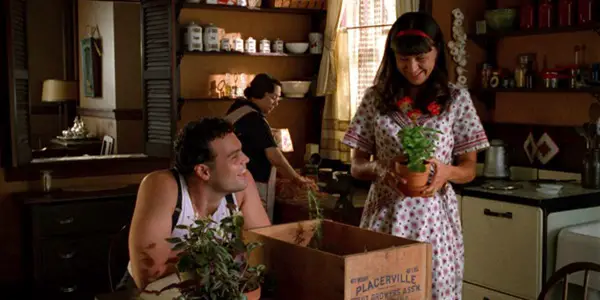
An Italian-American folk tale full of humor and tragedy, Household Saints has been so difficult to track down since its initial 1993 release that it was practically considered lost. But, fortunately for us all, this beautiful, strange, and utterly singular little film has finally been resurrected in the form of a new 4K restoration, courtesy of Kino Lorber and Milestone Films.
Adapted by director Nancy Savoca (Dogfight) and her husband and filmmaking partner, Rich Guay, from the 1981 novel by Francine Prose, Household Saints chronicles the lives of three generations of Italian-American women in New York’s Little Italy and their different viewpoints on everything from food to family to faith—especially faith. The clash between the spiritual and the secular is front and center, yet what makes the film so remarkable is that there are no easy answers as to which way is right. It portrays life as the hearty mix of the mundane and the miraculous that anyone—even the least religious among us—can recognize as the real thing.
Marriage, Meat, and Miracles
As a multigenerational Italian-American family sits down to a meal, the grandparents reminisce about the “miracle sausages” they used to purchase from the Santangelo family. But as delicious as they may have been, it wasn’t the flavor that earned them that moniker; it was the Santangelos’ daughter, Teresa (Lili Taylor), a saint who could work miracles. From there, the story winds backward into the past—specifically, to the Saint Gennaro Feast during the summer of 1949, when the heat was so intense that butcher shop owner Joseph Santangelo (Vincent D’Onofrio) stayed home to play Pinochle with his neighbors, wagering blasts of cold air from his meat locker over the cards.
So desperate is radio repairman Lino Falconetti (Victor Argo) to win another moment of cold that he offers up his shy, homely daughter Catherine (Tracey Ullman) to cover his bet. Lino doesn’t expect Joseph to win, let alone demand that he pay up. But, that he does, and soon, Joseph and Catherine are married, much to the chagrin of Joseph’s mother, Carmela (Judith Malina), a stalwart of the Old World who cannot believe that her only son would consent to marry someone with no money, no luck, no looks, and no talent in the kitchen.
source: Kino Lorber
Carmela’s gloomy, icon-filled apartment contains just as much superstition as it does sausage meat; her old-fashioned ways stifle the younger generation, especially when Catherine becomes pregnant for the first time. It’s only after Carmela dies that Catherine can seize control of her life and home: putting the religious icons away, painting the dark walls a series of midcentury pastels, and giving birth to a beloved daughter, Teresa, without worrying about what old wives’ tales might say. But Carmela’s all-consuming spirituality lives on in the form of Teresa, who grows into a young woman so devout that she only dreams of joining a convent and devoting her life to small, saintly acts in tribute to Jesus Christ.
The Little Flower of Little Italy
The world of Household Saints is one in which magical realism runs like an undercurrent through everyday life, one in which a couple’s first time making love can cause bubbles to float to the ceiling and where a baby can be born with wings because its mother saw an animal being slaughtered while she was pregnant. Are these events real, or are they imagined? When Catherine comes downstairs to see that all of the plants she had forgotten to water are now back in full bloom, is it a miracle of resurrection, or merely a kind act on the part of her husband, who replaced all of the dead plants while she was in bed upstairs? Some things, such as those plants, can be easily explained away by modern logic, but others seem to be leftover relics of another age, one that will never truly fade away as long as some people still believe. Those beliefs can be harmful or they can be helpful, but they live on regardless—and they’re deeply familiar to anyone who has ever practiced Catholicism.
source: Kino Lorber
The first half of the film functions as an earthy and endearing romantic comedy, chronicling the awkward love story of Joseph and Catherine and the latter’s attempts to stand up to her husband’s mother. D’Onofrio has never been more charming and attractive than he is here, dedicated to legitimately wooing Catherine whatever the cards may say, while Ullman is remarkably restrained, rendering Catherine a compelling portrait of womanhood struggling to bloom into full flower despite the oppressive conditions of her existence. Malina is also excellent as Carmela, adding much-needed complexity to the archetype of the overbearing mother-in-law. But it’s Lili Taylor’s Independent Spirit Award-winning performance in the second half as the saintly Teresa that steals the movie right out from under all of them.
Beatific and beautiful with her wide, innocent eyes and dark, center-parted hair, Taylor looks like a religious icon—and indeed, her Teresa wants to be just like Saint Therese of Lisieux, the “Little Flower” who devoted her life to small deeds that go unacknowledged and underappreciated. For Teresa, this means obsessively scrubbing floors and ironing the shirts of her sort-of boyfriend (an amusing Michael Imperioli) until she has a vision of Jesus himself. Teresa’s actions are dismissed as madness by everyone else around her—but isn’t that also what they said about the saints back in the day? Household Saints allows this question to hover in the air, casting a mystical shadow over even the most secular thinkers. Even if you do not share Teresa’s blind belief, Taylor’s intensely compelling performance cannot help but mesmerize you.
source: Kino Lorber
Teresa’s dedication to canonization elicits moments both painfully funny and heartbreakingly sad, yet the most tragic throughline in Household Saints concerns Catherine’s brother, Nicky Falconetti (a deeply moving Michael Rispoli). A World War II veteran who is devoted to opera—especially Madame Butterfly—he obsesses over Japanese culture and dreams of marrying an Asian woman, prowling the streets of Chinatown as he descends into loneliness, depression, and alcoholism. His devotion, clearly a form of undiagnosed wartime PTSD, is just as powerful as Teresa’s, but while hers gives her hope and happiness, his mostly results in despair. Both remain utter mysteries to even their closest family members, yet the film has such incredible empathy for them that it’s impossible for the audience to not feel the same.
Even though the film was shot in Wilmington, North Carolina, Household Saints depicts a Little Italy that is lively and rich with sensory detail; you can practically feel the heat and humidity that drenches the Pinochle players with sweat and smell the frying sausages that tempt Teresa to give up on a hunger strike. Savoca, who grew up in the Bronx as the daughter of immigrants from Sicily and Argentina, knows this world and makes it feel fully authentic, as though each scene has been dredged up from her memories. This is a film in which New York is just as vibrant of a character as the human beings that gossip in its crowded streets and light prayer candles in its cramped apartments. It’s a New York that doesn’t really exist anymore, and to see it depicted onscreen is a reminder of everything we’ve lost as the years roll by. Like so much spirituality, it too is a relic of another age—and it is films like Household Saints that keep it and its people from completely fading away.
Conclusion
Household Saints is a prime example of the kind of spirited independent filmmaking that rose to prominence in the 1990s but has dwindled as budgets bloom, profits boom, and reliable franchises are deemed better investments than artistic risks. It’s a strange yet satisfying brew of family drama and spiritual contemplation that deserves the broader audience it has been denied while out of circulation.
The new 4K restoration of Household Saints opens on January 12 at the IFC Center in New York and on January 26 at American Cinematheque in Los Angeles.
Does content like this matter to you?
Become a Member and support film journalism. Unlock access to all of Film Inquiry`s great articles. Join a community of like-minded readers who are passionate about cinema – get access to our private members Network, give back to independent filmmakers, and more.










